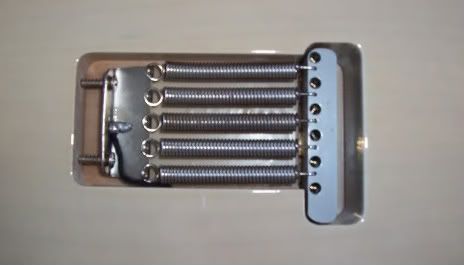Hello, I'm currently tuning my guitar and since I've changed the gauge of my strings from .09 to .1, I have to adjust the tension of the springs. I wanted to know if my springs must remain at the same level. Because I thought I might have to add more tension to the springs of the higher strings to compensate for the tension on the neck but when I bought my guitar, the springs where at the same level of tension.
Hey there! Looks as if you have been patient - I hope you got your guitar, which I noted is an Ibanez all set to your liking. I have various Strats and an Ibanez too. The purple one is right here at my fingertips; also I do my own work 99 percent of the time. I have strings from .09's to .10's and Hybrid Slinkys inbetween. I strongly prefer the .10's, so when I change from OEM or stock lights, which are usually .09's, YES, I adjust the springs. You don't have to but if you are fussy about your trem's action, or want to achieve a specific action and movement, while maintaining intonation, you might want to adjust springs too. As you have thought, if you left the springs even or in their original position, heavier strings pull the trem's tail up.
See below, the Plum Crazy Strat is my most-floating trem, it's American Standard with the bridge pivoting on two posts. The spring configuration is strange, with the unexpected treble side tightened additionally inward, but that is what it needed to get the action or mobility shown further below. I believe I needed slightly higher action or more clearance on the bass side, so backed-out the left-side post a little less than a quarter turn, instead of messing with the saddles some more, as they follow the fingerboard's radius. Trem works well BOTH ways, up and down. It's a kinda fun feeling? Really, it plays like a dream, like putty in the hands, no buzzes, very stable, and noticeably different than original trem setups.
I think this one is right on spec, since I re-measured after posting before that the pennies were 1/16" thick. No, they are actually 1/24" thick, so 3 pennies = 3/24" or 1/8" which is what Fender calls for in their set-up or technical support. That's the measurement between the bridge plate and the body, also the amount of sustain block exposed or visible underneath.
The other extreme, or opposite end of the spectrum is shown on this home-made Ash and thin-skin Nitrocellulose guitar. 2 more springs cranked down (claw tightened in), and a large sustain block allow its rocking-front-edge bridge to push down as a one-way whammy while it sustains like a hardtail, since the bridge lies flat, especially at the back, just touching. No rear holes or trem cover, that's a little anti-establishment too but says you can do what you want to do. :lol:
Like a bird on the wire,
like a drunk in a midnight choir
I have tried in my way to be free.






